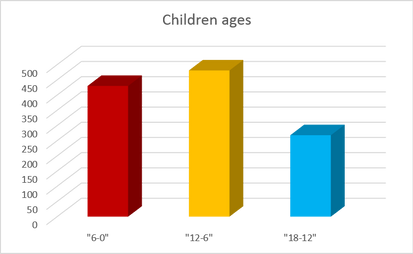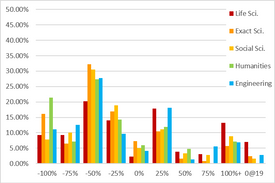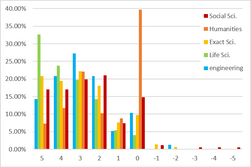In brief
The survey results reflect above all an extreme impact on the research productivity of early career faculty. Even if some impacts and causes are rated slightly higher than others, all aspects surveyed were rated as severely harmful. All impacts were also estimated to have a long term effect of up to 1 year or more even after the pandemic is over. This means much effort should be directed both towards managing the crisis as well as towards future recovery.
The highest reported harm is the inability to make an impact within the research community, which is fully backed by quantitative reporting of relative effect on academic lectures. Recognition by the community and developing a sound reputation as independent researchers are among top priority tasks of young researchers. Yet, even though the academic community has resorted to virtual gatherings, it seems the virtual stage is not offered to early career researchers.
Female researchers report greater harm on ALL causes and impacts surveyed. These subjective reports are also backed in numbers by women having submitted less publications and less proposals relative to men. The divide is largest when it comes to family needs, which is rated as the main cause of harm. If not addressed properly and promptly, these might increase the gender imbalance in academia.
While lack of mentoring and guidance were marked low as causes of harm, these can be better utilized as efficient tools to improve the managing skills and the ability to conduct research in such times of uncertainty. We should also be aware that the challenges faculty face in the early stages of their career in recruiting and managing their research teams, as well as the mental stress inflicted on them, are main causes of harm.
Survey structure
The survey had 4 main sections:
1. Profiles - characterizing the academic and personal profile of respondents:
-
Institution
-
Field of research
-
Research method
-
Years passed since hiring
-
Tenure
-
Gender
-
Number of children
-
Children age groups
2. Impacts - the impact the pandemic had on reserach productivity, each rated between 5 (extreme harm) through 0 (no effect) to -5 (extreme benefit):
-
Ability to conduct research
-
Ability to manage the research team
-
Ability to manage collaborations
- Ability to publish
- Ability to make an impact within the research community
- Ability to meet mandatory benchmarks
- Ability to develop research proposals
- Total impact on reserach productivity
For each of those we also asked to estimate whether there would be a short or long term effect (defined as less or more than 1 year after the pandemic ends, respectively) and what would be the estimated impact on promotion
3. Impacts in numbers - the number of products attained during the pandemic (since March 2020) and during normal time (throughout 2019):
-
Number of academic talks given
-
Number of publications submitted
-
Number of research proposals submitted
4. Causes - the causes for those impacts on research productivity, each rated between 5 (causing extreme harm) through 0 (has no effect) to -5 (causing extreme benefit):
-
Transition to virtual teaching
-
Execution of available research funding
-
Research team productivity
-
Availability of research resources and infrastructure
-
Family needs
-
Mental strength, ability to focus
-
Availability of mentoring and guidance
Surveyed population
The survey was distributed among all early career faculty, defined as those hired during the last decade, at all Israeli universities and reserach institutions (8 in total). During the 10 days the survey was open (Dec 29, 2020 to Jan 8, 2021) 874 responded out of a target group of about 2500 reserachers, representing about 35% of total early career reserachers in Israel (similar response rate per institute). The profile of the responants is diverse, representing well various fields of reserach, reserach methodologies, years passed since hiring (with slight over-representation of those hired in recent years), tenure, gender and parenthood (both number of children and age groups).
Main impacts on research productivity
Out of all impacts surveyed, the one that was rated as having the most extreme effect on research productivity was the ability to make an impact within the research community. The mean mark is 3.33, with 35% reporting the most extreme harm (5) and 75% reporting major harm (3-5). We find little variance among respondents profiles, where untenured and recently hired researchers report slightly greater harm.
This is backed by the change in the number of academic talks given during the pandemic relative to normal times. Almost 1/3 of all respondents report a complete halt - 0 talks given during the pandemic (-100%), and 80% report the number of talks was cut by 50% or more.

The 2nd-highest impact is the ability to conduct research with a mean mark of 2.99. Social sciences and humanities are more severely affected than STEM fields (+15% mark 5) and so do experimentalists in comparison to theorists (+12% mark 5). Women also report a greater effect than men.
The 3rd-highest rated impact is the ability to manage the research team with a mean mark of 2.85. Researchers in their 1st year report a substantially greater harm, intensified by their inability to recruit their first students. Untenured researchers are also affected more severely.
Another major impact is the ability to publish, rated 5th with mean of 2.62. We find here much stronger impact on social sciences and humanities than STEM (+20% mark 5). The gender imbalance is also extreme, with women reporting much greater harm. The level of harm also increases with lowering children's age groups.
The ability to publish was also surveyed in the quantitative section. The total distribution indeed shows an overall decrease in number of publications submitted during the pandemic that peaks at -50% loss. Field cut identifies the reported loss in humanities as well as in exact sciences. Life sciences present close to equal distribution between harm and benefit. Women are indeed over-represented on the strongly harmed quantitative report.
Long term impacts
The overwhelming majority of about 80% of respondents estimate the harms surveyed will continue to impact their research productivity even after the pandemic is over. Among those, 43% estimate the impact will continue to last for up to 1 year and 36% for an even longer period. This is true both for the distribution reported on the total impact (shown here) and on the specific harms with little variance.
As a long term impact we surveyed the estimated effect on the next academic promotion. The majority of untenured faculty (over 50%) estimate their promotion will be substantially delayed, while 12% fear their chance of being tenured is in danger. The majority of tenured faculty estimate there would be no impact on their next promotion, though about a third estimate it would be delayed by the pandemic.

Tenured
Untenured
Benefit
No
impact
subst.
delay
Subst.
less chance

None
Short term
Long term
Causes impacting research productivity
The highest rated cause impacting research productivity is family needs with mean mark of 3.55. 39% reported the most extreme harm (5) and 75% reported major harm (3-5). The largest profile variance we find under gender, where almost 20% more women report extreme harm than men. Social sciences and humanities also report greater harm, though these seem to be correlated with gender imbalance.
The 2nd-highest rated cause is the research team's productivity with mean mark of 2.85. Here life sciences and experimentalists are most susceptible. Untenured faculty also rate this cause higher than tenured.
The 3rd-highest rated cause is the mental strength, calmness and ability to concentrate with mean mark of 2.45. Untenured and female researchers are somewhat more susceptible to such stress, and so are young parents.
The 4th-highest rated cause is virtual teaching with mean mark of 2.13. Untenured and female researchers report higher effect. Teaching load is broadly discussed probably since it has direct impact on research time allocation.



































